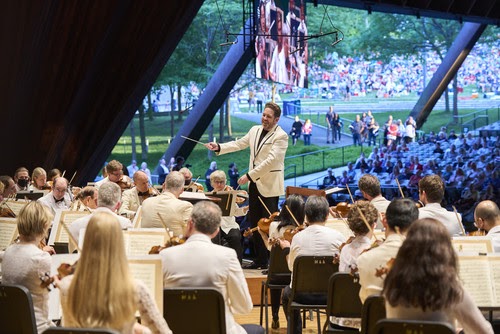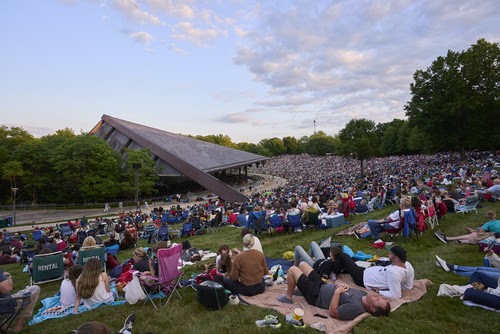by Timothy Robson

Speaking from the stage, CEO André Gremillet welcomed the large audience, which included a very full lawn seating area, and a well-spaced pavilion crowd. He noted that this was the Orchestra’s first performance in fifteen months that included full winds and brass — streamed concerts during the past season emphasized strings and percussion. He especially noted that all members of the ensemble are healthy. In closing, he introduced The Cleveland Orchestra, who then filed onstage to a thunderous standing ovation. The emotion was palpable in the audience.
As Gremillet exited, conductor Brett Mitchell bounded onstage and pointed to the snare drum, leading into a stirring performance of The Star-Spangled Banner, with orchestra and audience standing, complete with cannons at the appropriate moments.
July 4th concerts usually have “must-play” works, and this was no exception. After a few words of introduction, Mitchell and the Orchestra launched into a manic reading of Leonard Bernstein’s Overture to Candide. Later in the program, Tchaikovsky’s Overture: The Year 1812 made its obligatory appearance.
Mitchell wondered aloud why an orchestral work about a European battle over 200 years ago involving French and Russian armies has such a hold on American Independence Day. There are two answers: Arthur Fiedler made it a staple with the Boston Pops by relentlessly programming it; and audiences want to hear the cannons, which indeed were impressive, but probably not appreciated by the young parents with infant children who had just gone to sleep.
Three works by African American composers were the highlights of the concert. All of them should be adopted into the Orchestra’s standard repertoire. Mary D. Watkins’ “Soul of Remembrance” from Five Movements in Color (1993) was especially moving. The mood is both nostalgic and bittersweet, with beautiful melodies and lush, American Romantic harmonies and orchestrations. There is a slow, steady pulse throughout as the musical material develops, with wind descants soaring above the melody, finally reaching a full-orchestra climax before fading back to a single violin note at the conclusion. If the other movements of Watkins’ suite are of this quality, the whole set should be performed. This composer, born in 1939 and still living, deserves attention from a broad audience.
In recent years, the music of Florence B. Price has been rediscovered after neglect of more than five decades. Her Symphony No. 4 has been recently revived by several big-name orchestras, and on this program her Concerto in One Movement for solo piano and orchestra made a strong impression, especially with Michelle Cann as soloist. Cann holds degrees from the Cleveland Institute of Music, where she studied with Paul Schenly and Daniel Shapiro. She is now on the faculty of the Curtis Institute.
Price’s orchestral music is influenced by European Romanticism — especially Brahms and Grieg in this concerto — but also by African American spirituals. The work is in three distinct sections, separated by brief transitional passages, and the orchestrations are full-textured. The second, slow section was especially powerful, with the piano accompanied by a solo oboe (and later cello) obbligato. The third section is a jaunty “Juba” dance, with both virtuosic solo piano passages and moments in which the soloist fills in the orchestral texture.
Michelle Cann has become a strong advocate for Price’s music, and she played the Concerto authoritatively. As an encore, Cann offered the second, dream-like movement of Price’s Piano Sonata in e. It was gorgeous.
The real “find” on this program was Adolphus Hailstork’s 1985 An American Fanfare for brass and percussion — Hailstork’s response to Aaron Copland’s Fanfare for the Common Man, but with more musical substance and variety, and treacherous, jagged leaps across octaves.
Copland’s Appalachian Spring made its almost obligatory appearance, in a pristine, carefully developed performance. But on a longish program, it perhaps wasn’t necessary. After the Tchaikovsky, the concert ended with John Philip Sousa’s evergreen The Stars and Stripes Forever. Only a curmudgeon could scoff at how much fun it was, and how much The Cleveland Orchestra deserved their third standing ovation of the concert at its end.
Photos by Roger Mastroianni, courtesy of The Cleveland Orchestra.
Published on ClevelandClassical.com July 7, 2021.
Click here for a printable copy of this article





